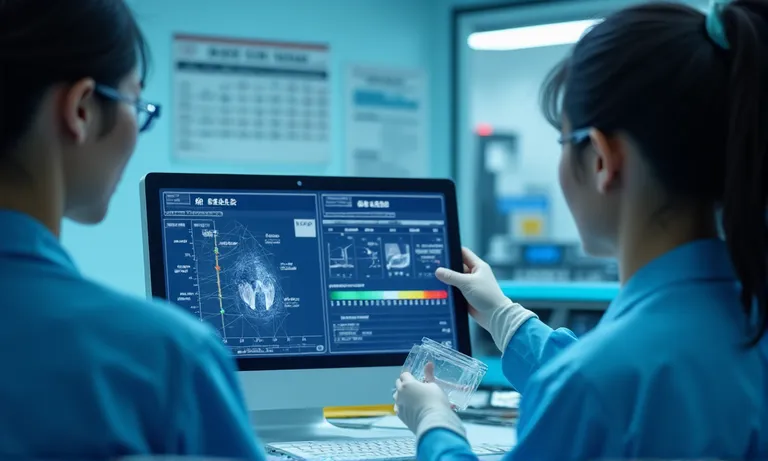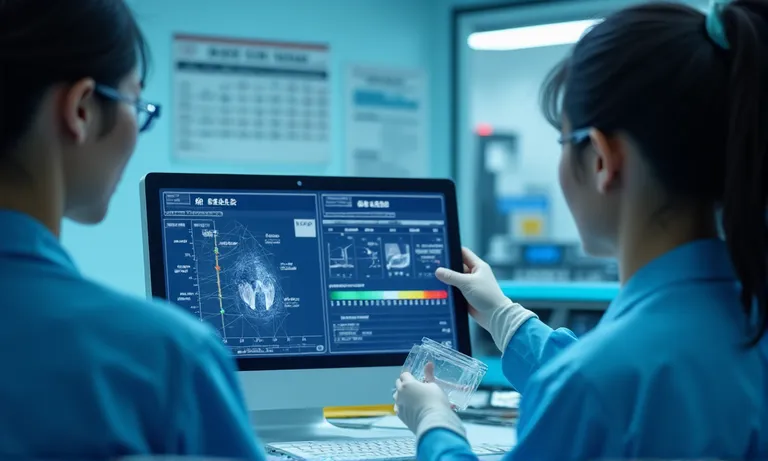Optimizing digital workflows with a Chinese dental lab requires a structured, system-driven approach that aligns technology, communication, and execution. The most effective partnerships are built on three pillars: using compatible digital tools (such as STL file standards and cloud platforms), establishing clear and responsive communication protocols, and implementing standardized SOPs that reduce delays and prevent remakes.
To succeed, overseas clinics and DSOs must focus on:
- Choosing interoperable systems that support secure data transfer and real-time case tracking
- Streamlining approval workflows with clear escalation paths and version control
- Training teams on both sides to ensure consistency and reduce friction across time zones
These strategies help transform digital workflows from isolated uploads into collaborative ecosystems that scale with volume and complexity.
Read on to explore how each component—from file handling to escalation protocols—can strengthen your collaboration with Chinese dental labs.
How to Streamline Digital Workflow Integration with Chinese Dental Labs
Optimizing digital collaboration with Chinese dental labs starts with compatibility, standardization, and responsiveness. To ensure seamless integration, overseas dental teams must focus on how their lab partners handle file compatibility, data security, and real-time communication across borders. Streamlining the digital workflow isn’t just about going paperless—it’s about building a repeatable, accurate, and flexible system that scales with case volume and clinical complexity.

dental-lab-digital-integration-interface
What Are the Key Factors for Running a Cross-Border Digital Workflow with Chinese Labs
Successful cross-border digital integration requires clarity in expectations and consistency in execution. From data preparation to platform coordination, each phase must eliminate ambiguity and minimize latency.
Key factors include:
- STL file readiness: Ensure files are exported with clean margins, scan flags removed, and bite alignment confirmed before submission.
- Timezone-aware scheduling: Align task handoffs to leverage time differences—overnight processing is often possible with China-based labs.
- Multichannel communication: Use structured platforms like email + WhatsApp + lab portal, not just ad hoc messaging, to manage feedback cycles.
Chinese labs like Raytops often work in coordinated shifts to support clients across multiple time zones, enhancing case responsiveness.
How to Handle STL File Compatibility and Secure Data Transfers in Dental Outsourcing
Ensuring STL compatibility and protecting patient data are non-negotiables in digital collaboration. Labs and clinics must align their tech stack and compliance protocols early in the partnership.
Best practices include:
- Use industry-standard STL formats: Avoid proprietary exports; ensure clean mesh integrity and scan body visibility.
- Secure file portals: Opt for HIPAA-compliant upload systems or encrypted file transfer tools, rather than unsecured links.
- Version labeling and checksum validation: Each upload should include metadata (date, case ID) and optional hash validation for traceability.
Many labs now integrate secure upload systems into platforms like 3Shape Communicate or custom portals, maintaining file integrity across the production chain.
How Cloud Platforms Enable Real-Time Collaboration with Offshore Dental Labs
Cloud platforms enable more than just uploads—they support real-time review, annotation, and asynchronous case decisions across time zones.
Platform-enabled advantages:
- Case tracking dashboards: View real-time case status, technician notes, and design previews from any browser-based portal.
- Collaborative CAD review: Comment on margin lines or pontic contour before finalizing the design—without lengthy email chains.
- Automated notifications: Get updates when designs are ready, revisions are uploaded, or approvals are pending.
By using shared cloud environments, overseas clinics can reduce turnaround loops, catch design mismatches early, and maintain synchronized records with offshore production teams.
✅ Reliable digital workflows require more than just STL uploads – TRUE
A successful digital workflow involves alignment in file standards, secured data exchange, and collaborative cloud infrastructure to reduce latency and avoid costly remakes.
❌ Sending files via email attachments is sufficient for cross-border workflows – FALSE
Unstructured file transfer methods introduce version confusion, data security risks, and slow approvals—ultimately impacting delivery consistency and patient outcomes.
Does a Digital Workflow Improve Turnaround Time and Case Accuracy in Dental Lab Collaboration
when implemented properly, digital workflows shorten turnaround cycles and boost accuracy by reducing manual steps and enabling early issue detection. For overseas clinics and DSOs working with offshore dental labs, digital workflows aren’t just a tech upgrade—they are an operational advantage. The key is not the tool itself, but how well both sides integrate design, feedback, and approval in a predictable rhythm.

dental-lab-turnaround-efficiency-digital-workflow
Can Automated Dental Design and Manufacturing Help Reduce Remake Rates
Automated digital workflows reduce human error by enforcing design constraints and surfacing inconsistencies early. This is particularly valuable in multi-case, multi-location collaborations where remake risk accumulates quickly.
Ways automation reduces remakes:
- Parametric CAD templates: Base designs follow predefined anatomic curves and occlusal standards, improving consistency.
- Pre-check algorithms: Automatic margin detection, undercut warning, and insertion path checks prevent design oversights.
- Integrated approval workflows: Clinics receive real-time design previews and approve or reject before milling starts.
At Raytops, automated checkpoints catch over 80% of critical errors before final production, dramatically lowering remake frequencies for overseas clients.
Which Digital Tools Help Accelerate Case Approval and Feedback in Lab Workflows
Speed depends not only on manufacturing time but also on how quickly clinics and labs exchange feedback. The right tools can compress this cycle significantly.
Common tools that speed up collaboration:
- 3Shape Communicate: Enables live annotations, margin reviews, and design approvals directly in-browser.
- Auto-notification systems: Remind clinicians of pending tasks (design review, shade approval), minimizing idle case days.
- Shared case dashboards: Track which stage each case is in—scanning, designing, waiting approval, or milling.
These tools centralize communication and eliminate back-and-forth emails, a common source of delay in cross-border cases.
How Digital Manufacturing Enhances Consistency Across Batches
Digital workflows don’t just make individual cases faster—they also enhance batch-level consistency. For labs handling 50+ units daily, this matters.
Key consistency boosters:
- Standardized design libraries: Use repeatable base designs for common cases (e.g., posterior crowns, bridges).
- CNC-driven milling accuracy: Digitally calibrated equipment removes variation from technician hand-finishing.
- Data traceability: Archived STL files and settings allow consistent reproduction of case features across remakes or future restorations.
This is especially helpful for DSOs managing multiple locations and expecting uniform outcomes regardless of clinic or region.
✅ Digital workflows enable faster turnaround and fewer remakes – TRUE
When both lab and clinic adopt digital collaboration tools, it eliminates redundant steps and catches potential issues earlier, reducing delays and do-overs.
❌ Digital tools alone guarantee better outcomes – FALSE
Technology must be matched by clear SOPs, training, and shared standards. Without alignment, even the best tools can’t prevent miscommunication or poor designs.
What Does a Successful SOP Look Like for Digital Collaboration with Dental Labs
A successful SOP in digital lab collaboration defines how information flows, who approves what, and when escalations occur—without ambiguity. For overseas clinics and DSOs working with dental labs, a clear SOP reduces case delays, limits remake risks, and makes scaling predictable. It’s less about fancy tech, more about mutual discipline and documentation.

dental-lab-digital-sop-process-mapping
How File Naming Conventions and Version Control Prevent Errors in Lab Submissions
File chaos is one of the leading causes of delay and misfabrication in cross-border workflows. A simple but consistent naming protocol prevents confusion, especially when handling dozens of cases per day.
Effective naming & version control practices:
- Standard naming templates: e.g.,
PatientID_Date_ClinicCode_DesignType.stl - Version suffixes: Use
_v1,_v2,_finalto distinguish iterations and approvals. - Central upload logs: Timestamped logs and upload confirmations reduce version mismatch.
At Raytops, we often set up joint naming protocols with our partners during onboarding, ensuring every case is traceable from scan to final shipment.
How to Set Up Clear Approval and Escalation Processes in a Digital Dental Workflow
The fastest workflows are not those without feedback, but those with structured feedback rules. Escalation logic prevents bottlenecks when key stakeholders are unavailable.
Components of a well-structured approval & escalation flow:
| Stage | Responsible Party | Escalation Rule |
|---|---|---|
| Design Review | Clinic Coordinator | Escalate if no action in 24h |
| Final Design Approval | Lead Dentist / DSO Rep | Escalate to Clinical Director if >48h |
| Shade Confirmation | Patient-side Staff | Auto-approve with previous reference shade |
These guidelines should be documented, agreed upon, and built into cloud platforms when possible.
How SOPs Help Align Multi-Clinic and Multi-Lab Collaborations
For DSOs or lab networks managing complex multi-site flows, SOPs become the shared language of operations. Without them, digital transformation often collapses under inconsistency.
Benefits of SOP-driven collaboration:
- Unified terminology: All locations use the same language for scan types, restoration codes, and case tags.
- Cross-training guides: Technicians and clinic staff can train new team members with less risk of deviation.
- KPI benchmarking: Clear checkpoints allow review of turnaround time, approval lag, and error rates per partner.
SOPs are especially important when outsourcing to Chinese dental labs, where timezone and language differences may amplify process gaps without strong documentation.
✅ Digital SOPs help prevent delays and ensure quality – TRUE
A structured SOP defines the who, when, and how of collaboration, eliminating guesswork and driving consistent case outcomes.
❌ Digital workflows can function efficiently without documented SOPs – FALSE
Without clear protocols, even well-designed platforms lead to approval gaps, remakes, and patient dissatisfaction.
Optimizing digital workflows with Chinese dental labs is not just about adopting new tools—it’s about building mutual clarity, predictability, and accountability into every case. The real gains come when overseas teams and lab partners move beyond ad hoc file transfers to structured, repeatable processes that minimize error and maximize efficiency.
From our experience supporting digital transitions for global clients, the turning point often lies in small details: a standardized file name, a clearly defined approval window, or a technician who knows exactly when to escalate. These aren’t just operational tweaks—they’re signals of whether a partnership is ready to scale.
If you’re looking to strengthen digital collaboration with an offshore lab partner, investing in a clear, well-integrated workflow is the most sustainable way forward. We’ve helped partners of all sizes—from single-site clinics to multinational DSOs—establish reliable, scalable systems that support long-term growth.
Want to explore how our team can support your digital workflow integration? Let’s start a conversation.


